
Francesco Albani stands as a significant figure in the landscape of Italian Baroque art. An accomplished painter hailing from the Bolognese school, his work bridged the classical ideals inherited from the Renaissance with the burgeoning dynamism and emotional depth of the Baroque era. His long and productive career saw him active in major artistic centers, leaving behind a legacy characterized by lyrical beauty, mythological narratives, and devotional sincerity.
Early Life and Artistic Formation in Bologna
Francesco Albani was born in Bologna, Italy, with sources citing either March 17th or 18th, 1578. His father was a prosperous silk merchant who initially envisioned his son following him into the family business. However, the young Albani demonstrated a strong inclination towards the arts, ultimately persuading his father to allow him to pursue painting as a vocation. This decision set him on a path that would lead him to become one of the most respected painters of his generation.
His formal artistic training began in Bologna, a vibrant center for art at the time. He first entered the studio of the Flemish painter Denis Calvaert (also known as Denys Calvaert), a respected Mannerist artist working in the city. In Calvaert's studio, Albani would have received a solid grounding in drawing and the fundamentals of painting. It was also here that he likely first encountered Guido Reni, another aspiring artist who would become both a lifelong friend and a professional rival.
Seeking a more progressive artistic environment, Albani, alongside Guido Reni, soon moved to the Accademia degli Incamminati ("Academy of the Progressives" or "Academy of Those Taking the Right Path"). This influential academy was founded by the Carracci family – Ludovico Carracci and his cousins, Agostino Carracci and Annibale Carracci. The Carracci sought to reform painting by rejecting the artificiality of late Mannerism and advocating a return to naturalism, anatomical accuracy, clear composition, and the study of Renaissance masters like Raphael and Correggio, combined with drawing from life.
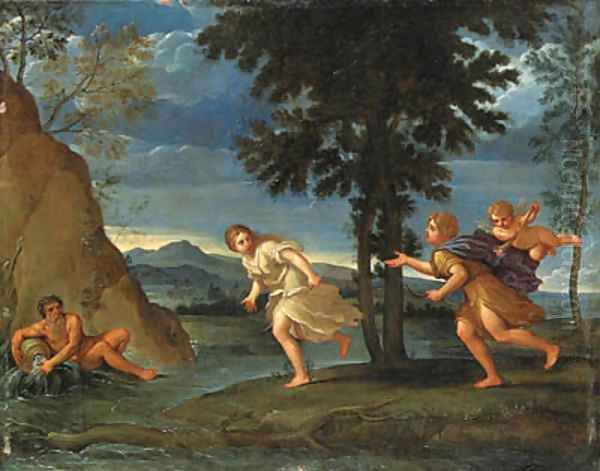
Under the guidance of the Carracci, particularly Ludovico who remained primarily in Bologna, Albani honed his skills. He absorbed the academy's emphasis on strong draftsmanship, balanced composition, and the expressive potential of light and shadow. The Bolognese school, shaped significantly by the Carracci academy, became known for a style that often blended classical restraint with Baroque sentiment, a characteristic that would define much of Albani's own work.
The Roman Period and Major Commissions
Around the year 1600 or 1601, seeking broader opportunities and exposure, Francesco Albani moved to Rome. This was a pivotal moment, as Rome, under the patronage of Popes like Clement VIII and later the Borghese and Barberini families, was the epicenter of the burgeoning Baroque movement. It was a city attracting artists from all over Italy and Europe, fostering intense competition and innovation.
In Rome, Albani reconnected with Annibale Carracci, who had been called there earlier to undertake the monumental task of decorating the gallery ceiling of the Palazzo Farnese. Albani became one of Annibale's most trusted assistants on this project, which is now considered a landmark of Baroque ceiling painting. Working alongside other talented Carracci pupils like Domenichino and Giovanni Lanfranco, Albani contributed significantly to the execution of Annibale's designs, gaining invaluable experience in large-scale fresco painting and absorbing Annibale's masterful synthesis of classical form and dynamic energy.
His talent did not go unnoticed. Following his work at the Palazzo Farnese, Albani began receiving independent commissions. He contributed frescoes to the Palazzo Mattei di Giove (sometimes referred to as Palazzo Mattei di San Pietro in sources), notably depicting scenes like Apollo and Daphne. He also worked extensively in the Palazzo Verospi (now Palazzo Verospi Vitelleschi), where he executed ceiling frescoes, including mythological cycles often cited as Venus and Cupids and The Seasons and Apollo.
Albani's reputation extended to religious commissions as well. He painted frescoes for the choir of the church of Santa Maria della Pace, including a notable Annunciation. He also undertook work for the church of San Sebastiano fuori le Mura and contributed to decorations in San Domenico di Giovanni da Udine. These projects solidified his standing as a leading painter in Rome, capable of handling both mythological and sacred subjects with grace and skill. His active period is generally considered to span from around 1601 until his death in 1660, during which he worked not only in Bologna and Rome but also undertook projects in Viterbo, Mantua, and Florence.
Artistic Style: Lyrical Classicism in a Baroque Age
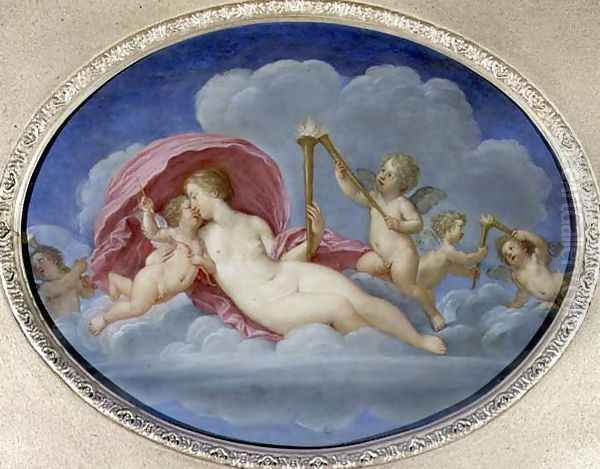
Francesco Albani's artistic style is often described as a lyrical and graceful interpretation of the Baroque. While trained in the Carracci tradition, which emphasized naturalism and classical structure, Albani developed a distinctive personal manner characterized by elegance, poetic sentiment, and a preference for harmonious compositions. His work often stands in contrast to the more dramatic intensity of Caravaggio or the exuberant dynamism of Peter Paul Rubens.
A key influence, acknowledged by contemporaries and evident in his work, was the High Renaissance master Raphael. Albani admired Raphael's clarity, idealized beauty, and balanced compositions, often infusing his own paintings with a similar sense of grace and serenity. However, he was undeniably an artist of the Baroque era. His figures possess a softness and warmth, his use of light, while often gentle, effectively models form and creates atmosphere, and his narratives, particularly the mythological ones, are imbued with a tender, sometimes playful, romanticism.
Albani excelled in depicting mythological and allegorical subjects, often set in idyllic landscapes. He became particularly famous for his charming depictions of Venus, cupids (putti), and nymphs, rendered with delicate brushwork and a soft palette. Works like The Sleeping Venus, Venus and Cupids, and Galatea on the Sea exemplify this aspect of his oeuvre. These paintings, often commissioned for private patrons, showcase his ability to create visually delightful scenes filled with graceful figures and gentle movement.
His religious works, such as The Holy Family or The Madonna at Prayer, carry a similar sensitivity. While adhering to devotional requirements, they often possess an intimate and tender quality. Figures are rendered with idealized beauty, and the emotional tone is typically one of serene piety rather than intense drama. Works like The Baptism of Christ demonstrate his ability to handle multi-figure compositions within a landscape setting, balancing narrative clarity with atmospheric effect.
While sometimes criticized by later commentators for lacking the power or profound depth of some contemporaries, Albani's consistent elegance, technical refinement, and poetic sensibility secured his reputation. He successfully blended the Bolognese emphasis on drawing and classical structure with a softer, more lyrical approach that appealed greatly to patrons of his time and influenced subsequent generations, particularly in the development of Rococo aesthetics.
Representative Works
Francesco Albani's prolific output includes frescoes, altarpieces, and cabinet paintings on mythological and religious themes. Some of his most notable works, reflecting the breadth of his subjects and skills, include:
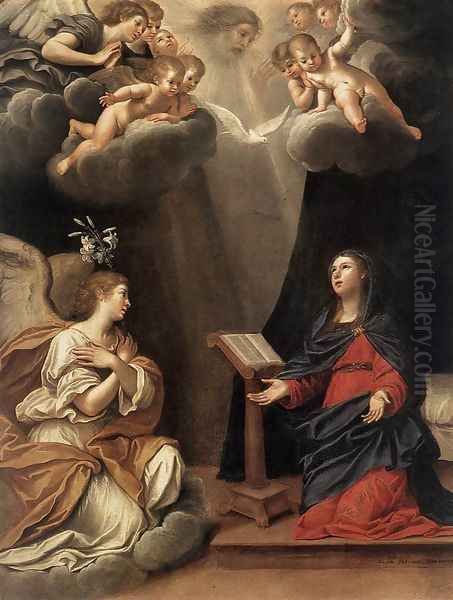
Frescoes in the Palazzo Farnese, Rome (c. 1602 onwards): As a key assistant to Annibale Carracci, Albani played a significant role in executing parts of this seminal Baroque ceiling decoration.
Frescoes in the Palazzo Verospi, Rome (c. 1611-1616): Including cycles such as The Story of Venus and The Seasons led by Apollo. These showcase his mature style in large-scale decorative work.
Frescoes in the Choir of Santa Maria della Pace, Rome: Featuring works like The Annunciation, demonstrating his ability in religious narrative fresco.
Frescoes in the Palazzo Mattei di Giove, Rome: Including mythological scenes like Apollo and Daphne.
The Baptism of Christ (c. 1630-1635): Housed in the Pinacoteca Nazionale, Bologna, this work exemplifies his handling of religious narrative within a landscape. Another version is noted alongside an Apollo and Daphne in the Uffizi Gallery, Florence.
The Holy Family (various versions): One notable example is in the Pitti Palace, Florence, showcasing his tender approach to sacred themes.
Venus Attended by Nymphs and Cupids (c. 1633): Located in the Prado Museum, Madrid, this is a prime example of his popular mythological cabinet paintings.
The Toilet of Venus (various versions): A recurring theme, with examples in the Louvre, Paris, and other collections, highlighting his graceful figure painting.
Landscape with Apollo and Mercury (c. 1630s): Demonstrating his skill in integrating mythological figures into idyllic landscape settings.
Noli me Tangere (c. 1625-1630): A religious work showing Christ appearing to Mary Magdalene, found in the Louvre, Paris.
The Annunciation (c. 1630s): An oil painting version, distinct from the fresco, located in the Hermitage Museum, St. Petersburg.
Danäe Reclining: Mentioned as one of his mythological subjects.
Galatea on the Sea: Another mythological theme associated with his name.
Hermaphroditus and Salmacis: A version noted as being in the Louvre.
Lamentation over the Dead Christ: A religious theme he depicted, showcasing his capacity for pathos.
The Fall of Phaeton and the Assembly of Gods: Attributed to him, possibly located in the Uffizi.
This list represents only a fraction of his output but indicates the range of his work, from large public frescoes to intimate private commissions, across both sacred and profane subjects.
Network: Teachers, Contemporaries, and Students
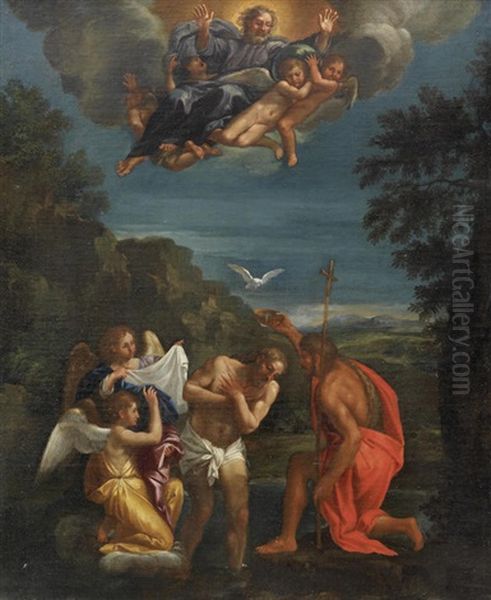
Francesco Albani's career was interwoven with the artistic fabric of his time. His network included influential teachers, prominent contemporaries, collaborators, and students who carried forward aspects of his style.
His primary teachers were Denis Calvaert and the Carracci (principally Ludovico Carracci in Bologna and Annibale Carracci in Rome, with Agostino Carracci also being a key figure in the Academy). These figures provided the foundation of his artistic education.
Among his most significant contemporaries was Guido Reni. They trained together, moved to Rome around the same time, and maintained a complex relationship marked by both friendship and intense professional rivalry. Both became leading figures of the Bolognese school, though Reni achieved perhaps greater international fame for his idealized classicism. Other important contemporaries and fellow pupils of the Carracci working in Rome included Domenichino (Domenico Zampieri) and Giovanni Lanfranco, both of whom Albani collaborated with under Annibale Carracci.
Albani also interacted with figures from other disciplines. The provided texts mention collaborations or support involving the pastoral poets Torquato Tasso (author of Jerusalem Delivered) and Guarino Guarini (though Guarini is primarily known as a major Baroque architect and theorist, not a poet in the same vein as Tasso; the nature of this "support" or collaboration might relate to shared patrons or thematic inspiration rather than direct artistic partnership). These connections suggest Albani moved within cultured circles where literature and art intersected.
Albani himself became an influential teacher. He maintained a large workshop, particularly after his return to Bologna. His most notable students included Andrea Sacchi, who became a major painter in Rome, known for his classical compositions that contrasted with the High Baroque style of Pietro da Cortona. Albani also taught his own brother, Giovanni Battista Albani, who became a painter in his own right, though less renowned than Francesco. Carlo Cignani, Pier Francesco Mola, and Giovanni Maria Galli da Bibiena are also sometimes mentioned as having passed through his studio or been influenced by him. His influence extended through his pupils and the enduring appeal of his graceful style.
Later Life and Legacy
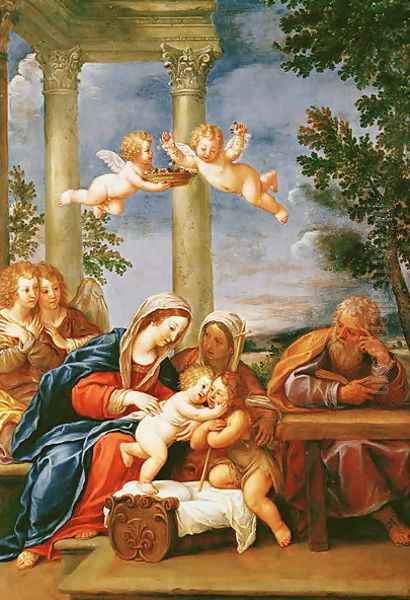
After a successful period in Rome and potentially working in other centers like Mantua and Florence, Francesco Albani eventually returned to his native Bologna. He established a prominent workshop there and continued to paint prolifically, focusing increasingly on mythological and allegorical cabinet pictures, which were highly sought after by collectors across Europe.
His later years were marked by continued artistic activity and his role as a teacher, guiding a new generation of Bolognese artists. He remained largely faithful to the elegant, classical-Baroque style he had developed, characterized by its lyrical charm and technical polish. While perhaps overshadowed in dramatic power by some Baroque contemporaries, his consistent quality and appealing subject matter ensured his continued success.
Sources mention aspects of his personal life, including his marriage (potentially two marriages, with one wife named Doralice Alvarez or Fioravante, according to different accounts) and that his wife and children often served as models for the graceful figures, particularly the numerous putti, that populate his canvases. This infusion of personal observation into his idealized scenes may contribute to their charm and vitality.
There are hints in the source material of personal or familial complexities. An early lawsuit involving Denis Calvaert's workshop is mentioned. The source also alludes to potential family controversies, such as his father Carlo Albani's exile for alleged murder prior to Francesco's fame, and perhaps reputational issues surrounding his brother Giovanni Francesco (though this might be a confusion with another relative or the brother Giovanni Battista). The intense rivalry with Guido Reni is also a recurring theme in accounts of his life. However, specific details regarding major personal scandals or unresolved mysteries directly involving Francesco the painter remain somewhat unclear or potentially conflated with other family members in the provided summaries. What is clear is that he navigated the competitive art world of his time to build a successful and respected career.
Francesco Albani died in Bologna on October 4, 1660, at the advanced age of 82.
Conclusion
Francesco Albani was a pivotal figure in the Bolognese school and a significant contributor to Italian Baroque painting. Emerging from the influential Carracci Academy, he forged a distinctive style that blended classical harmony, inspired by masters like Raphael, with the warmth and gentle dynamism characteristic of the Baroque sensibility. His move to Rome placed him at the heart of artistic innovation, where he collaborated on major projects like the Palazzo Farnese frescoes and established his reputation through independent commissions.
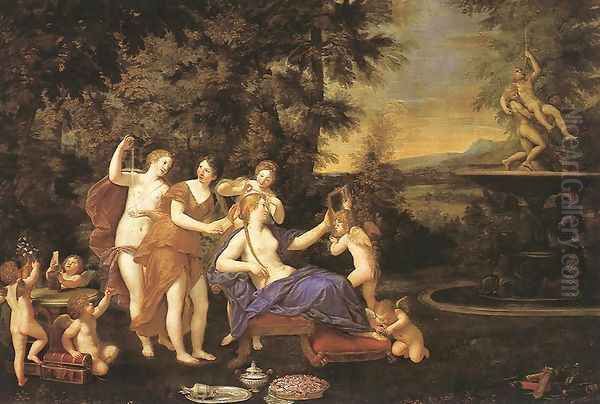
Known for his lyrical and often idyllic depictions of mythological and religious subjects, Albani's work is characterized by graceful figures, soft light, harmonious compositions, and delicate brushwork. He excelled particularly in cabinet paintings featuring Venus, cupids, and pastoral landscapes, which were highly prized by collectors. While maintaining a friendly yet competitive relationship with contemporaries like Guido Reni, Albani carved out his own niche, emphasizing elegance and poetic sentiment. Through his own prolific output and the students he trained, including Andrea Sacchi, Albani exerted a lasting influence on the course of Italian painting, representing a refined and accessible current within the broader stream of the Baroque. His art continues to be admired for its technical skill, its gentle beauty, and its charming evocation of classical myths and sacred stories.